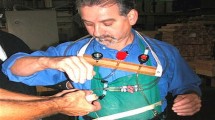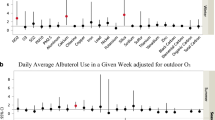Abstract
Introduction: There is a need to evaluate possible health effects of ventilation improvements and emissions from new buildings, in longitudinal studies. New methods to study biological effects on the eyes and upper airways are now available. Material and methods: A longitudinal study was performed on 83 trained social workers in two offices in Uppsala, Sweden. The exposed group (n= 57) moved to a newly redecorated building nearby. Low emitting building material had been used, including a new type of solvent-free water-based paint. The control group (n= 26) worked in the same office during the study period (November 1995 to February 1996). Hygiene management was carried out in both offices, at the beginning and the end of the investigation. Tear film stability (BUT) was measured. Nasal patency was measured by acoustic rhinometry, and eosinophilic cationic protein (ECP), myeloperoxidase (MPO), lysozyme and albumin were analyzed in nasal lavage fluid (NAL). Results: The relocation resulted in an increase in the personal outdoor airflow rate from 11 to 22 l/s. Indoor concentrations of terpenes were higher in the new building, and powdering of the new linoleum floor was observed. Measurements showed low levels of volatile organic compounds (VOC), formaldehyde, carbon dioxide (CO2), nitrogen dioxide, respirable dust, and microorganisms in the air of all buildings. The move resulted in an increased nasal patency and an increase of ECP and lysozyme in NAL, after adjusting for changes in the control group. No changes were observed for nasal or ocular symptoms. A seasonal effect, with a decrease of ECP, was observed in the control group. Conclusion: A well-ventilated office building can be redecorated without any major ocular or nasal effects, or measurable increase of indoor air pollution if low-emitting building materials are selected. In agreement with previous evidence, the improved ventilation flow may explain the increase of nasal patency. The increase of ECP and lysozyme in NAL suggested an inflammatory effect in the new building. Since this building had increased ventilation flow, increased concentrations of terpenes, and powdering from the polish on the new linoleum floor, identification of causative agents was difficult. The hygiene measures did not give any evidence that emissions from the new type of solvent-free water-based paints or building dampness were responsible for the observed nasal effects. Considering the higher emissions of VOC reported from older types of water-based latex paints and solvent-based wall paints, the new type of solvent-free water-based paint seems to be a good choice from the hygiene point of view.
Similar content being viewed by others
Author information
Authors and Affiliations
Additional information
Received: 21 December 1998 / Accepted: 20 June 1999
Rights and permissions
About this article
Cite this article
Wieslander, G., Norbäck, D., Wålinder, R. et al. Inflammation markers in nasal lavage, and nasal symptoms in relation to relocation to a newly painted building: a longitudinal study. Int Arch Occup Environ Health 72, 507–515 (1999). https://doi.org/10.1007/s004200050408
Issue Date:
DOI: https://doi.org/10.1007/s004200050408




